Self exercise of standing up and sitting down
Usually in Alexander Technique lesson, we call “chair work”, and a teacher will help a pupil to stand up from sitting position and to sitting down from standing position with hands on.
I do it in my lesson, too. But, what I introduce today is not a work with a teacher but “do-it-yourself” exercise of standing up and sitting down.
This is the most efficient way of standing up and sitting down. If you do this as an exercise repeatedly, you will get following benefits:
1. Detect your habit of giving excess muscle tension
2. Be able to apply efficient use to some of your daily activities and performances
3. Good for your back pain
Of course, this will help you daily activity of standing up from a chair and sitting down to it more easily.
This will be quite different from your usual way, but some of you feel “oh, it’s so easy” with this way. I will explain its tricks later.
Since this is a particular way, it doesn’t look normal. Try this as an exercise, and I will show you how you apply some ideas from this exercise to the usual activity of standing up from a chair and sitting down in the later.
Learn the movement step by step
Before we go, let’s check your own way of standing up and sitting down. Please find a chair, and try sitting down and standing up from a chair a couple of times in your usual way.
Now I show you a new way.
Firstable, let’s do sitting down sequence first and then move on to standing up sequence. Now, Let’s do it step by step.
Sitting down sequence
So, stand in front of a chair. One foot is little bit of in front of the other foot. Either foot would be fine.
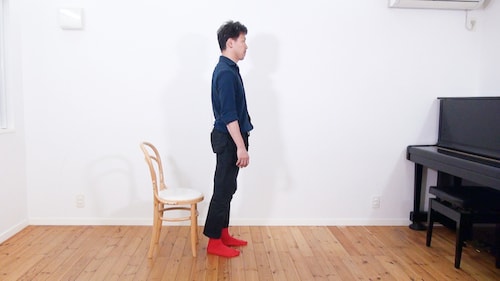
1. Making the chin down
*Look down also
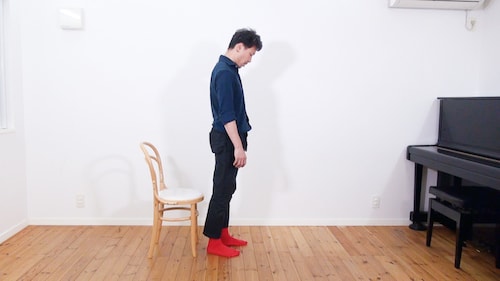
2. Making the hip back and incline the torso and head forward until the head’s coming over the toes
*Release the arms (try not to hold them)
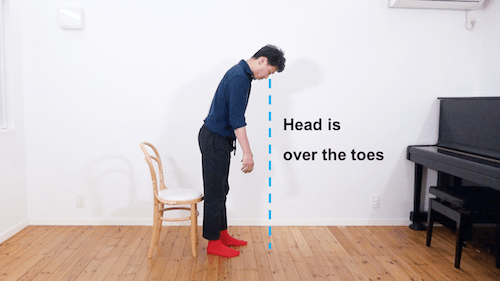
3. Bend the knees while keeping the head over the toes, and bring the body down to a chair
*Breath out easily (try not to cut breath)
*Feel the weight through the feet
*Keep the chin down
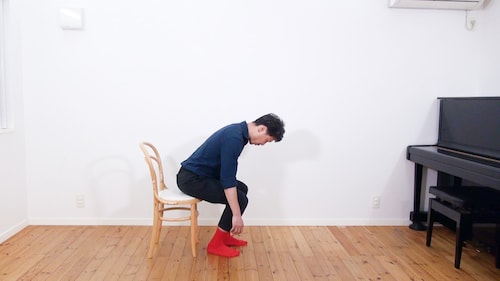
4. Bring up the torso and head on a chair
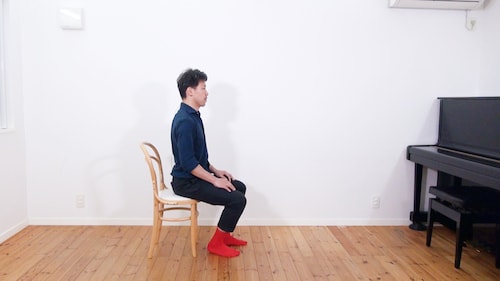
5. Rest your body on a chair
*Give your body weight on a chair, and breath out easily.
*Rest the head as the head can move anytime.
Standing up sequence
1. Make the chin down
*Look down
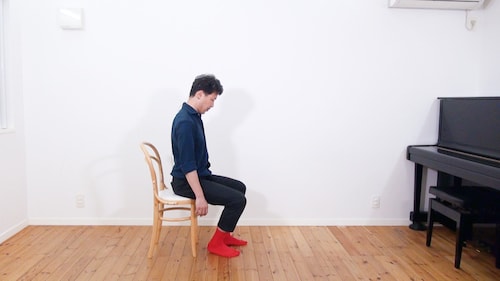
2. Move the head and torso forward until the head’s coming over the toes
*release the arms (try not to hold them)
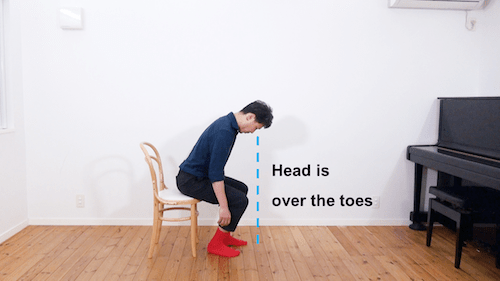
3. Push the floor and bring the whole body up
*Breath out easily (try not to cut breath)
*Keep the chin down
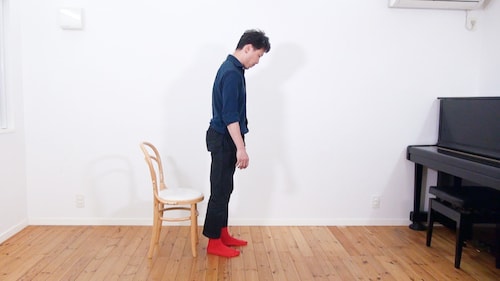
4. Bring the head up
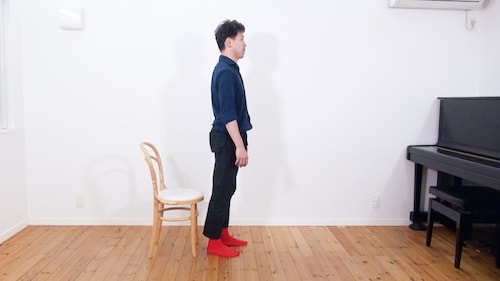
5. Rest your body on a floor
*Give your whole body weight on a floor, and breath out easily.
*Rest the head as the head can move anytime.
Repeat this procedure several times and get used to doing it.
How is it? It’s different, isn’t it?
The movement is very simple, but this exercise requires your consciousness, or thinking. This is not “just do it” exercise.
Think and move is the key for releasing habitual excess muscle tension. You will learn how you are thinking of your movement while you are doing something through this exercise.
5 tricks for the chair exercise
Now. I will explain 5 tricks, the reason why you can do this with minimum muscle contraction. All of them are in relation to how you support your body while doing this activity.
1. You managed the weight balance of your body in relation to the base of support.
People usually don’t manage the weight balance in relation to the base of support so well. For example, you may do this activity like this.
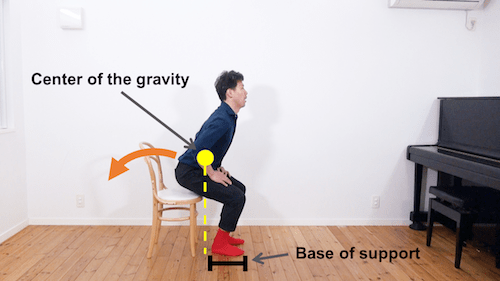
What this person is doing is to bring the hip up for standing while the center of gravity of the body is not above the base of support enough.
The base of support in sitting condition consists of the area from the feet to the hip. But in standing condition the base of support is just the feet. Once you bring the hip up, your base of support is only the feet. However, many people try to stand up when the center of gravity of the body is not enough on the base of support.
This means you are falling backward. Well, you don’t. It’s because you are using front muscles contraction to keep it.
If you place your center of gravity on the base of support before you bring the hip up, i.e., bring your head and torso forward until the head’s going over the toe, you won’t fall backward and you don’t need to give so much tension. All you do is to bring the body up, not pull forward against falling backward.
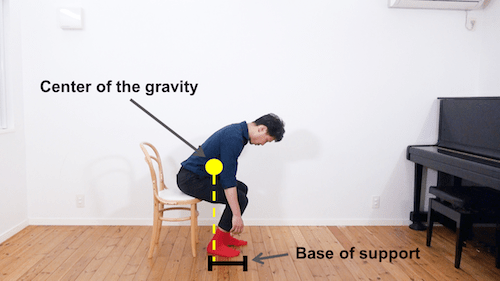
2. You avoided excess muscle tension of the neck muscles by managing the head position.
Many people pull their head back while standing up or sitting down. We don’t have to do this to standing up and sitting down. The neck tension will be more by doing this. This is because most of us don’t think of the head in action, and the head is moved by some forces.
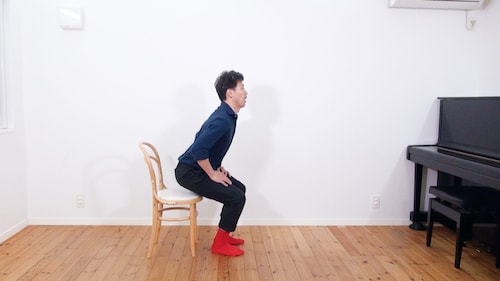
One reason is the inertia. It is object’s tendency to stop. When standing up, the torso will incline forward and the head will have tendency to stop there so that the head will rotate backward against the torso.

The other is receiving pulling force of the sternocleidmastoids, which is attached to the back of the skull so that its pull makes the head pull forward and rotate backward.
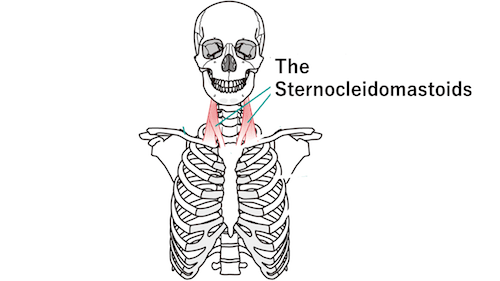
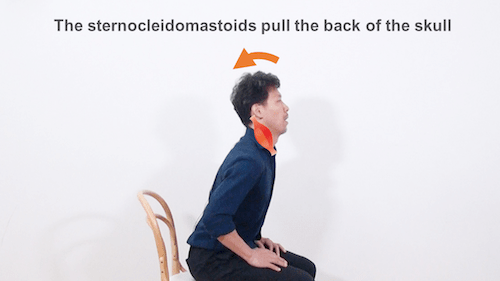
There are some forces acting to our head. If we don’t do anything with them, the head will be easily pulled backward and we cannot stop excess muscle tension.
To avoid this what we should do is to think of the head and to make the chin down a bit. We need to do this kind of small management for the neck tension.
3. You also avoided excess tension of the abdominal muscles by managing your breathing.
Many people give excess muscle tension in their abdominal muscles.
There is strong connection between the abdominal muscles and breathing. If you tight up the abdominal muscles, your breathing will stop. Especially, your exhaling will be restricted.
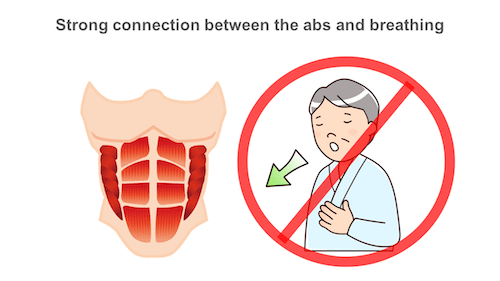
Many people tight up the abdominal muscles while standing up and sitting down. This is because people lean backward and using front muscles to support falling backward. But, again it’s not the best way. If we manage our weight distribution, we don’t have to add so much tension in the abdominal muscles. Anyway, because of tighting up the abdominal muscles people will cut breath when standing up and sitting down.
To release it, we manage weight distribution and consciously breathing out. Again, our breathing and the abdominal muscles are connected in terms of function. To release the tension in the abdominal muscles we need to breath out consciously.
The best breathing way is sighing like ha–. If the berry moves inflated and deflated according to breathing, it is the good sign that your abdominal muscles are released.
4. You avoided excess muscle tension of the arms and shoulders
Well, this is simple. It’s useless to give muscle contraction in the arms and shoulders for standing up from a chair and sitting down. All we do is to just stop this useless habitual muscle tension.
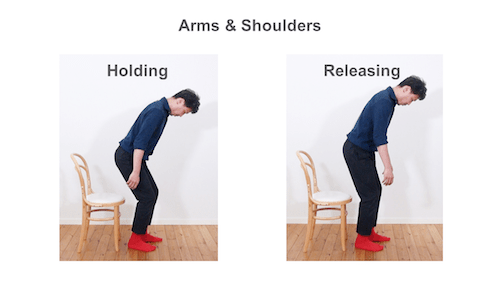
5. Go back to the original intention. What we are doing for standing up is to push floor.
We usually don’t have intention for this kind of daily activitiy. We are like “just do it”. Then, we tend to fall into disadvantageous habitual pattern of excess muscle tension.
To change this pattern it’s better for us to remind original intention of the action, which is “what we are doing” or “what we need to do”.
In the case of standing up, what we actually do is to push floor to bring the body up. This is the original intention of standing up from a chair, and we had better intend it in the action. By having this original intention we can use our muscle more efficiently.
These are the 5 tricks. Actually these tricks are the key points to release excess muscle tension.
So, by just practicing this chair exercise, you can learn the skill to get rid of your habitual pattern of giving excess muscle tension, not just for this particular activity but also for some other activities.
How to apply daily standing up and sitting down
Lastly, I just explain about application to daily standing up and sitting down.
Keep in mind 3 points from the procedures. One is “chin down first”. 2nd one is “push floor”, and 3rd one is “breath out like sigh” in standing up and sitting down.
Do some practices for your easier life and performance.

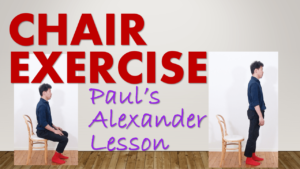
Comments